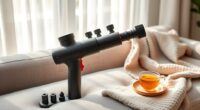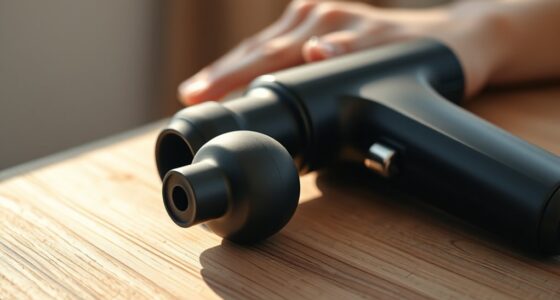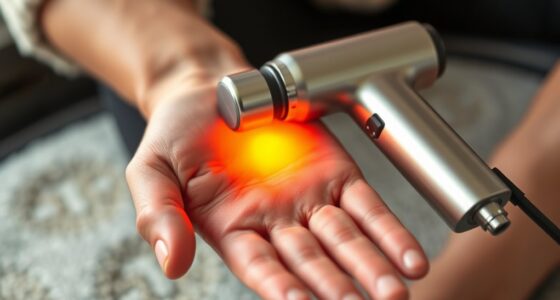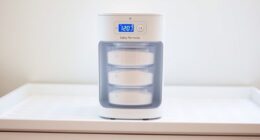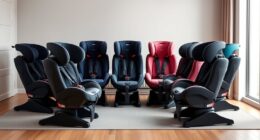Both compression boots and active recovery boost circulation effectively, but they do so through different means. Compression boots apply rhythmic pressure to muscles, promoting blood flow even at rest, while active recovery involves gentle movement that naturally increases circulation. The best choice depends on your needs—compression offers quick, passive relief, whereas active recovery encourages ongoing blood flow through activity. To discover more about how each method impacts your recovery, keep exploring the details below.
Key Takeaways
- Compression boots provide direct, uniform mechanical pressure that actively stimulates blood flow during rest.
- Active recovery increases circulation naturally through movement, promoting gradual blood flow enhancement.
- Compression offers immediate circulation benefits post-exercise, while active recovery sustains blood flow during activity.
- Combining both methods can optimize circulation by leveraging passive and active mechanisms.
- The choice depends on recovery goals, with compression boots suited for quick relief and active recovery for long-term circulation benefits.

When it comes to speeding up recovery after intense workouts, both compression boots and active recovery methods offer effective solutions. Each approach targets muscle fatigue and promotes circulation, but they do so in different ways. Compression boots use controlled pressure to stimulate your limbs, aiming to enhance blood flow and facilitate muscle relaxation. This process helps reduce swelling and soreness, making recovery smoother and quicker. By compressing the muscles in a rhythmic manner, they encourage blood to move efficiently through your veins, delivering oxygen and nutrients necessary for repair. The result is a feeling of relief, and your muscles become less tense, ready for your next session. Additionally, the use of certified sustainable products in some compression gear reflects a growing industry trend toward environmentally conscious manufacturing practices.
Compression boots promote recovery by using controlled pressure to boost blood flow and reduce muscle soreness effectively.
Active recovery, on the other hand, involves low-intensity activities such as walking, cycling, or light stretching. These activities keep your blood circulating without overloading your muscles, which is essential for recovery. When you engage in active recovery, your muscles stay warm and mobile, which prevents stiffness and promotes blood flow enhancement. This increased circulation helps clear metabolic waste products like lactic acid, reducing muscle soreness and speeding up the healing process. Active recovery also encourages your lymphatic system to drain fluids efficiently, decreasing swelling and inflammation. Plus, it stimulates your nervous system, which can improve overall muscle function and flexibility.
Both methods aim to improve circulation, but their mechanisms differ. Compression boots provide a direct mechanical stimulus, applying uniform pressure that promotes blood flow even when you’re at rest. This targeted approach can be especially beneficial after demanding workouts or competitions, where rapid muscle relaxation and circulation boost are needed. In contrast, active recovery relies on your body’s natural processes. Moving gently increases blood flow incrementally, helping your muscles recover without the need for any equipment. It’s a more accessible option, especially if you prefer exercising or want to incorporate recovery into your daily routine.
Choosing between compression boots and active recovery depends on your preferences and recovery needs. If you’re looking for a passive, high-tech solution that can quickly alleviate muscle tension and improve circulation even during rest, compression boots are a vital choice. However, if you prefer a more natural, cost-effective approach that also boosts blood flow through movement, active recovery might suit you better. Sometimes, combining both methods offers the best results, ensuring your muscles relax thoroughly while blood flow enhancement continues through gentle activity. Whichever route you pick, understanding how each promotes circulation and muscle relaxation will help you optimize your recovery process and get back to training stronger and faster.
Frequently Asked Questions
How Long Should I Use Compression Boots for Optimal Results?
For ideal results, you should follow the duration guidelines provided by the manufacturer, generally using compression boots for about 20 to 30 minutes per session. This timing allows your circulatory system to benefit without overdoing it. It’s best to incorporate these sessions into your routine after workouts or during recovery days, ensuring you give your muscles adequate time to rest and recover while maximizing circulation benefits.
Can Active Recovery Be Effective Immediately After Intense Workouts?
Did you know that active recovery can reduce muscle soreness by up to 50%? Yes, it’s effective immediately after intense workouts because it promotes blood flow, helping your muscles recover faster. Plus, it encourages mental relaxation, easing workout stress. So, you can jump into light activity right away, aiding your recovery process and calming your mind, making it a smart choice for post-exercise rejuvenation.
Are Compression Boots Suitable for People With Circulatory Issues?
If you have circulatory concerns, you should be cautious with compression boots. While they can improve circulation, some might find them uncomfortable or unsafe, especially if you have underlying issues like blood clots or varicose veins. Always check with your healthcare provider to confirm compression safety before using these devices. They can advise you on whether compression boots are suitable for your specific circulatory condition.
Do Active Recovery Methods Vary for Different Sports or Activities?
Imagine you’re a marathon runner needing sport-specific recovery, or a cyclist focusing on activity customization. Active recovery methods do differ for different sports or activities because each demands unique muscle engagement and recovery needs. For example, swimmers might prioritize gentle stretching, while weightlifters focus on light resistance exercises. Tailoring recovery strategies ensures you optimize circulation and reduce soreness, making your recovery more effective and aligned with your sport’s specific demands.
How Do Cost and Convenience Compare Between the Two Recovery Options?
When comparing recovery options, you’ll notice pricing differences and setup complexity matter. Compression boots tend to be pricier upfront and require more setup, like plugging in and adjusting settings. Active recovery is usually more affordable and simple—just stretch, walk, or foam roll. You’ll find active recovery more convenient for daily use, while compression boots make sense if you’re willing to invest and prefer a tech-driven solution.
Conclusion
Ultimately, both compression boots and active recovery boost circulation, but the real secret lies in consistency. Imagine feeling energized after every workout, knowing you’re giving your body what it needs to heal and perform better. It’s tempting to think one method is superior, but combining both might be the game-changer. Trust in your routine, stay committed, and watch your circulation—and your progress—reach new heights. Your body deserves the best shot at recovery.

